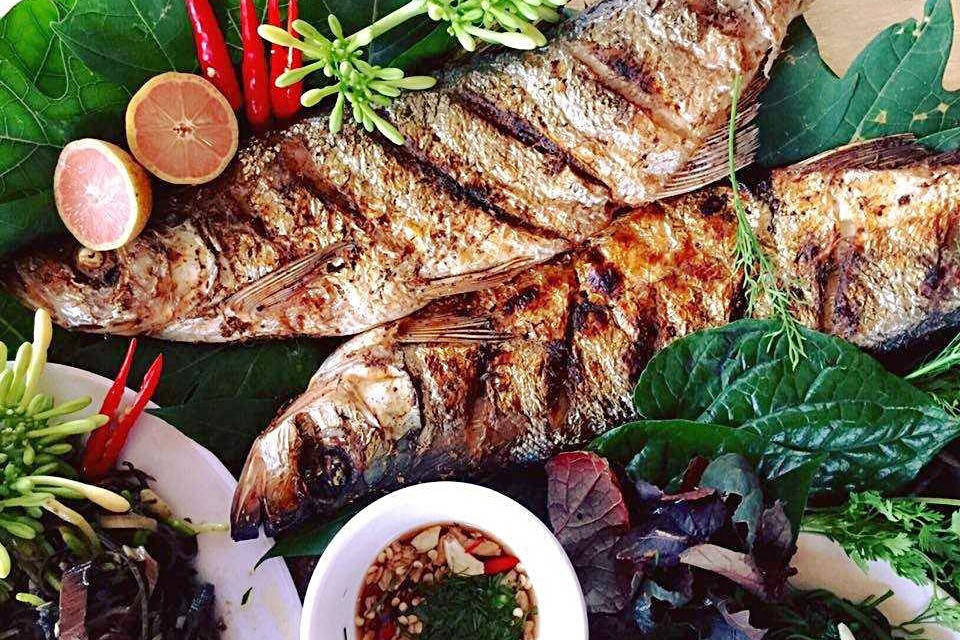
Must-Try Dishes That Define Da Bac's Rich Culinary Heritage
- on Jul 28, 2025 By: Phuong Mai NGUYEN
Nestled in Vietnam's northern highlands, Da Bac, Hoa Binh, is a hidden gem offering more than just breathtaking landscapes; it's a vibrant tapestry of ethnic cultures, whose culinary traditions are deeply intertwined with their heritage and environment.
This guide invites you on a delectable journey through Da Bac's essential "must-try" dishes, promising an authentic taste of tradition, nature's bounty, and the warm spirit of its people.
Fermented pork
The fermented pork from Da Bac is a culinary masterpiece of the Dao Tien people, particularly from Sung village, renowned for its meticulous multi-year fermentation process that yields a truly unparalleled flavor profile deeply rooted in local heritage. This extraordinary commitment of time—1 to 3 years, or even up to 10 years—offers a tangible "slow food" experience where time itself is a key ingredient, creating a depth of flavor and cultural significance unmatched by faster methods.
When perfectly ripened, the pork boasts a rich, fragrant, and balanced taste. The fat portion, ideally 9 parts fat to 1 part lean, becomes crispy and rich, while the lean meat is chewy and intensely flavorful. A pleasant sourness distinguishes the flavor from the fermented rice ("mẻ” in Vietnamese) that complements the inherent sweetness and aroma of the pork. Locals often enjoy it wrapped in fresh betel leaves or various wild vegetables, adding layers of earthy freshness.

The process starts with high-quality, naturally fed pork that is washed, sliced, salted, and fermented in a jar for 2-3 months. Hot cooked rice is added and ferments into "mẻ,' cooking the meat over time. The rice layer is refreshed every 6 months to a year, with the entire process lasting 1-10 years, reflecting the Dao Tien people's traditional, resourceful methods developed for mountain food storage.
Fermented pork holds immense cultural value for the Dao Tien people in Sung village. It is an essential dish for ancestral altars during festivals, Tet (Lunar New Year), weddings, and engagements, symbolizing respect and continuity. Every household often keeps several jars ready, reflecting its status as a staple and the community's pride in preserving this time-honored tradition.
Hoang Wine
Hoang wine (Rượu Hoẵng in Vietnamese) is the liquid embodiment of Dao Tien culture from Sung village, offering a unique taste and a legendary experience that makes it an essential part of any visit to Da Bac. Its distinctive preparation and the vivid descriptions of its effects—"drink until the end of the party still sober, but walk three more kilometers and get drunk," with intoxication reportedly lasting for three days—transform this beverage into an unforgettable cultural narrative, demonstrating how local folklore enhances its appeal.
Made from upland sticky rice, Rượu Hoẵng from Sung village boasts a fragrant aroma and a pale yellow color that deepens with each batch. It is described as having a sweet taste on the tip of the tongue and a smooth, inviting aroma, making it deceptively easy to drink.
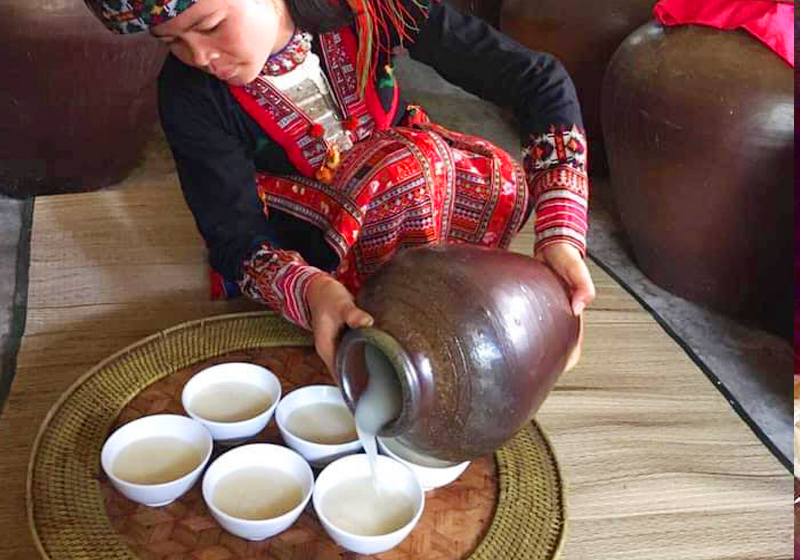
The meticulous process involves soaking sticky rice for 7-8 hours, steaming it, cooling it, and then mixing it with a traditional yeast formula. After 7-8 days of fermentation, the "raw wine" liquid is extracted. The unique distillation method involves placing this liquid in a ceramic jar, which is then heated indirectly with charcoal until it boils. This indirect heating, avoiding direct fire contact, is crucial for preserving its color and enhancing its rich flavor, distinguishing it from other rice wines. Proper storage in sealed ceramic jars is vital, as it loses aroma and spoils quickly if transferred to plastic cans or bottles. This traditional knowledge not only ensures the wine's unique quality but also implicitly suggests a sustainable approach to production, relying on natural materials and methods.
Grilled Da River Fish
Experiencing grilled Da River fish is to taste the very essence of Da Bac's natural environment, making it a true regional specialty and a compelling reason for food enthusiasts to visit. Sourced directly from the majestic Da River, this grilled fish offers unparalleled freshness, firm meat, and a smoky aroma that reflects the region's traditional cooking methods and deep connection to its aquatic bounty.

Da River fish, including species like carp, catfish, and hemibagrus, are known for their firm, fragrant, sweet, and low-fat meat due to their natural habitat. When grilled, the fish develops a delicious smoky flavor. The fish is freshly caught from the Da River. Some meticulous households marinate the fish with ginger, lemongrass, galangal, onions, "hạt dổi", and “mắc khén” (special Northwest spices). It is then traditionally wrapped in banana leaves or clamped between bamboo sticks and grilled over red charcoal. The cook continuously fans the charcoal and flips the fish to ensure even cooking, a crispy skin, and to prevent burning. Another variation involves sun-drying the fish until firm before grilling, resulting in a firmer texture.
Fish from the Da River is a fundamental staple for communities along its banks, particularly the Muong people, reflecting their close relationship with the river. Grilled fish is a common and beloved dish in family meals and a popular roadside offering for tourists, especially in winter. The communal dining experience, with food served on banana leaves, highlights a strong sense of community and tradition, where food is shared and enjoyed together, symbolizing the river's sustenance and the region's culinary identity.
Da Bac Free-Range Chicken
The meat of Da Bac's free-range chickens is consistently fragrant and sweet, considering they are raised naturally in the mountainous terrain, which helps develop a superior texture and flavor that industrial farming cannot replicate. While the chickens are typically of moderate size, their deliciousness is undeniable. When grilled, the skin achieves a slight char, while the meat inside remains incredibly sweet and moist, offering a delightful contrast in textures. Depending on personal preference, hosts can prepare the chicken by grilling, boiling, or steaming, allowing visitors to savor its distinct taste in various forms. This simplicity suggests that the inherent quality of the ingredient is so high that it does not require elaborate masking, offering a refreshing and honest culinary experience that celebrates the ingredient itself.
Da Bac free-range chicken represents the simplicity and purity of highland living. It is a testament to the quality of naturally raised produce in Da Bac and a common, highly praised dish enjoyed by both locals and tourists, reflecting the region's commitment to fresh, wholesome ingredients.
Grilled Wild Pork
Da Bac Grilled Wild Pork offers a distinctive taste derived from naturally raised "wild pigs," setting it apart from conventionally farmed pork and making it a savory mountain delicacy that consistently receives high praise from visitors.
The pork is typically sliced to an appropriate size and marinated with "mắc khén", which imparts a unique aromatic quality. It is then grilled until golden, ensuring a perfect balance of crispy exterior and tender, juicy interior. The natural rearing of the pigs is a crucial factor in the meat's distinct and highly complemented taste. The pairing of naturally raised pork with "mắc khén" demonstrates a deep understanding of how local spices can elevate and complement the inherent flavors of regional produce, creating a unique and authentic taste experience.
This must-try dish highlights Da Bac's reliance on and appreciation for naturally raised livestock. Its widespread availability in local eateries and its popularity among tourists underscore its status as a beloved local specialty, embodying the rustic and authentic flavors of the mountainous region.
Forest Mouse Meat
For the truly adventurous palate, forest mouse meat offers a unique and authentic taste of Dao Tien culture, making it an unparalleled culinary adventure and a rare glimpse into traditional highland life. Its profound historical and ritualistic significance, stemming from its role as a crucial means of survival during difficult times and its elevation to an indispensable staple for important ceremonies, reveals a powerful narrative of resilience and cultural adaptation. For tourists, trying this astonishing dish offers a profound connection to the community's history and enduring identity.
To prepare for festivals, forest rats are hunted in bamboo forests, cassava, and cornfields, typically in November and December, using elaborate bamboo traps. Once caught, they are singed, gutted, cleaned, marinated with spices, and then hung over the kitchen stove to be dried by smoke until golden. Before cooking, the dried meat is washed, chopped, and stir-fried in hot oil with seasonings until tender.
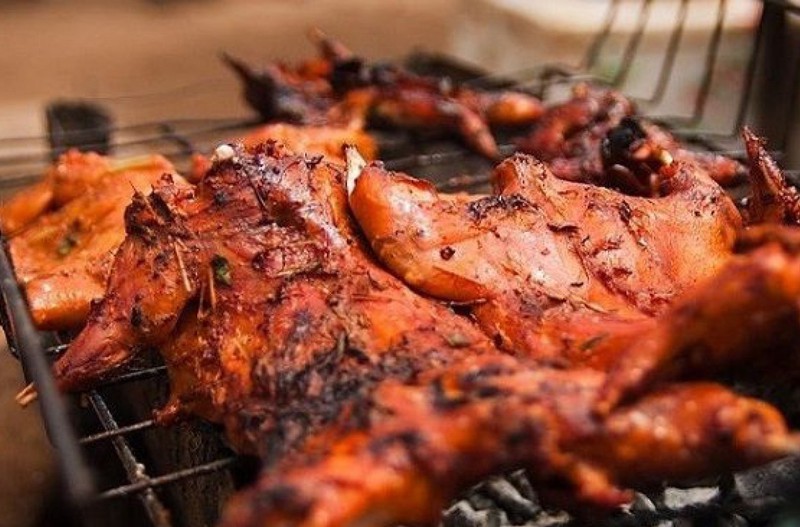
As stated above, this dish holds deep cultural and ritualistic importance for the Dao Tien people. It is an essential offering on the ancestral altar during the three-day Tet holiday, symbolizing deep respect and gratitude, and believed to ensure blessings for prosperity and health. The meat for offerings must be caught by the head of the household, not purchased, emphasizing sincerity. The Dao Tien believe no other meat can replace it for New Year's Eve offerings, as village spirits and ancestors only accept this "traditional" specialty. This highlights a strong sense of ritual purity and adherence to traditional foodways, indicating that for the Dao Tien, certain foods transcend mere sustenance to become sacred objects.
Leaf Tray Feast
Leaf Tray Feast, or Cỗ Lá, is not merely a meal; it is a profound cultural experience and a visual spectacle. This unique Muong tradition of serving an entire feast on forest banana leaves embodies the deep affection and generosity of the Muong people, offering a diverse array of flavors and an intimate glimpse into their communal spirit. The use of forest banana leaves instead of conventional plates is a deeply symbolic act, representing the Muong people's profound connection to their natural environment and implying inherent sustainability. For eco-conscious travelers, this aspect adds significant value, making the Cỗ Lá a must-try not just for its taste but for its environmental and cultural message.
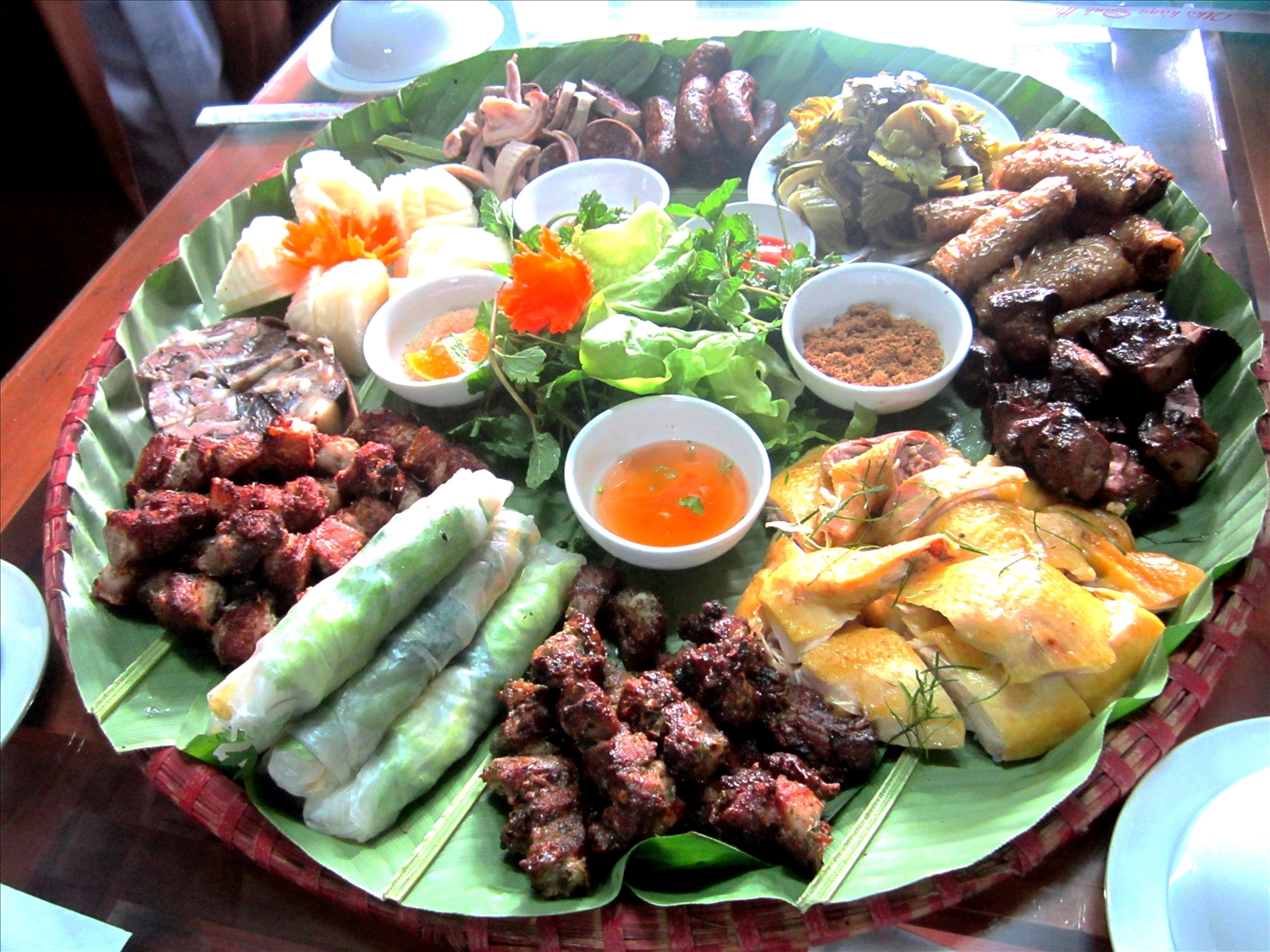
The feast features a lively presentation, with many dishes carefully arranged on large, flexible forest banana leaves, selected for their size and thickness rather than plates. These leaves are gently warmed over a fire to soften them, release their unique fragrance, and make dish placement easier. This warming imparts a subtle, earthy smell to the feast. Diners experience a symphony of flavors, from various pork dishes (boiled and grilled), chicken, and grilled fish, to sticky rice, pickled bamboo shoots, and an assortment of aromatic herbs. The dishes are often dipped in a special salt with "hạt dổi," adding a distinct local touch.
Cỗ Lá is a primal and sophisticated aspect of Muong culinary culture, preserved for significant occasions such as festivals, New Year celebrations, weddings, and funerals. It symbolizes the Muong people's deep connection to the land, sky, forests, and mountains. Partaking in a Cỗ Lá allows visitors to not only savor the flavors but also perceive the simple, sincere emotions, etiquette, and customs of the Muong people, expressed through the feast's arrangement, seating, and eating style.
Da Bac's culinary landscape is defined by its reliance on natural, often wild-sourced ingredients, time-honored preparation methods passed down through generations, and the deep cultural and ritualistic significance embedded in each dish. From the patient artistry of Thịt chua to the communal joy of Cỗ Lá and the adventurous taste of forest mouse meat, each dish is a window into the soul of its ethnic communities, shaped by generations of tradition and the pristine bounty of the highlands. By experiencing these dishes, visitors not only savor unique flavors but also engage directly with local cultures, support traditional livelihoods, and contribute to the preservation of invaluable heritage.
Don't just read about it – experience it. Plan a trip to Da Bac, Hoa Binh, and immerse yourself in a culinary adventure that promises not just delicious food but a profound connection to culture, nature, and the warm hospitality of its people.
Related articles:
>> Explore the Charm of Da Bac: A Hidden Gem in Hoa Binh Vietnam
>> Where to Stay in Da Bac : 12 Best Homestays for an Authentic Experience
 Español
Español Français
Français







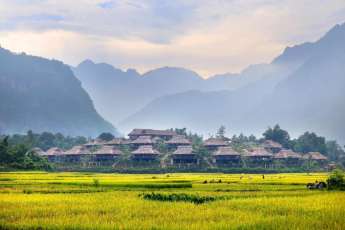


.jpg)

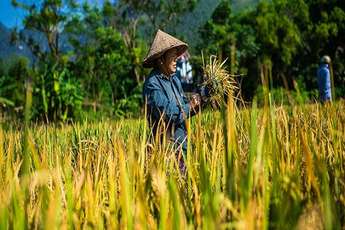







Morgane Ter Cock
on Dec 18, 2025HerbertPhomaMS
on Oct 19, 2025Lilyan Cuttler
on Oct 15, 2025Avenue17XC
on Sep 14, 2025Avenue18JL
on Jul 21, 2025